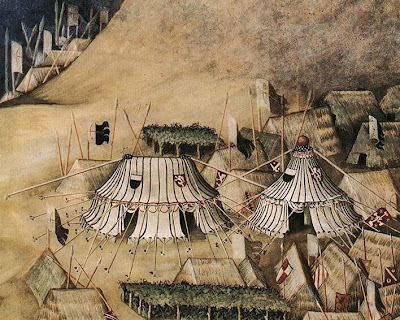Friday, November 08, 2013
Medieval Tent Structures
From the top: Images 1-3 rope spread roofs 1: Equestrian portrait of Guidoriccio da Fogliano (detail) Simone Martini 1328-30 2-3 St. Martin renounces his arms (details) Simone Martini 1312-17. 4 Tent roofs supported by radial ribs. BL Add. 12228, f.150 (detail) Roman du Roy Meliadus de Leonnoys c. 1352 5-6 Pavilions and tents with vertical slats in the walls King René's Le Cueur d'Amours Espris c. 1457 7: Pavilion or tent with a rigid peripheral structure at the shoulder: Agnolo Gaddi: The Dream of Emperor Heraclius ca. 1385-87
Medieval tents used at least four different structural designs.
The tent spread by ropes alone is recognizable by catenary sag visible in the profile of the roof and walls, the shoulder attached to closely spaced guy ropes or crow's feet; although even so, there may be visible horizontal sag between the attachment points, and by guy ropes that descend no steeper than the roof profile, which typically produces a broad footprint for each tent on the ground.
Tents with radial ribs in the roof are clearly recognizable when the roof profile is convex. The yurts and gers of Central Asia still use radial ribs, with a roof profile that is either straight or convex.
Tents with walls stiffened by slats or battens are suggested when the walls slope without any indication of sag or drape, when a contemporary illustration suggests that they are present within channels in the wall, or when documentary evidence mentions them. King René's accounts for 1453 mention "rods for the wall of the said pavilion" and rods are also included in the itemized materials for a pavilion probably written by a Milanese tailor around 1540 in Il Libro del Sarto.
Finally, by the second half of the 14th century it seems to have been common for medieval tents to have had a rigid internal frame at the shoulder of the tent, circular, polygonal, oval or rectangular as the shape of the tent demanded, with circular the most common design. The Dream of Emperor Heraclius shows many of the features of this design. A limited number of guy ropes, if any, steady the tent. They descend at a steeper angle than the roof profile, and are insufficient to produce the roof plan shown by themselves. The tent valance forms a perfectly smooth cylinder.
Subscribe to:
Post Comments (Atom)







2 comments:
Unsurprisingly, it's a popular destination which often gets booked out quickly in high season. campshores.com has more information on the Privacy Policy | Camp Shores.
Great valuable tips! Thanks
Post a Comment